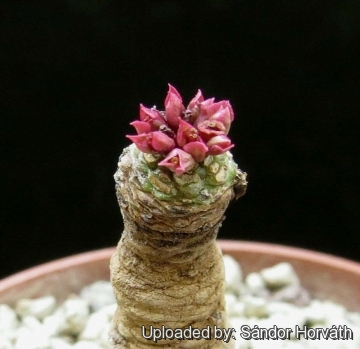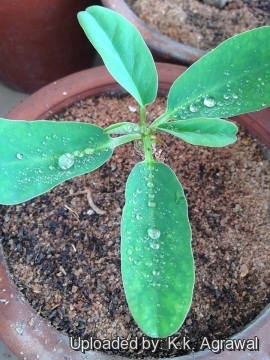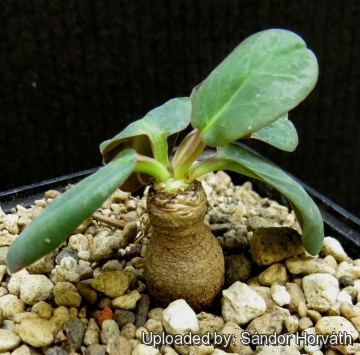
Euphorbia brunellii Photo by: Sándor Horváth
Origin and Habitat: Euphorbia brunelliiSN|29196]]SN|29196]] is locally common in Ethiopia, Kenya, Sudan and Uganda; possibly more widespread than records indicate.
Altitude range: 1100-2500 metres above sea level.
Habitat and Ecology: It is sporadically found in dry rocky plateaus at higher altitudes in grasslands, open deciduous forests and scrublands, usually in sandy well-drained soils overlying basement rocks, rarely in poorly drained soils and among dark grey volcanic rock.
Synonyms:
Description: Euphorbia brunelliiSN|29196]]SN|29196]] is a small geophyte, perennial, succulent plant that flowers early in spring before putting out the leaves.
Derivation of specific name: The specific epithet “brunellii” has been bestowed in honour of the Swedish botanist H.E.Brunell.
Rootstock: Tuberous about 2-3(-6) cm across, tapering abruptly into a long descending root, with several horizontal lateral roots. The tuberous rootstok (often improperly called a caudex) is very decorative and in cultivated plants it is almost always raised above the soil. When the "caudex" shape of the raised rootstok is adequately in evidence this plant is incomparable.
Stems: One to few underground branches about 3 cm long by 1(-2) cm in diameter derives from the rootstock and bear a cluster of leaves just at ground level. These stocky branches are closely covered with tessellated leaf-scars.
Leaves: Oval to elliptical. It will shed leaves quickly, leaving numerous scars. Leaves are shed whenever the conditions become arid.
Flowers (cyathia): White or pinkish appearing before the leaves.
Fruits ( capsules): Triangular about 3 mm long, typical for this genus and after ripening in a very warm day the capsules expel oval, bumpy seeds, a little over 1 mm long.
Bibliography: Major references and further lectures
1) “Euphorbia brunellii Chiov.“ in: African Plants Database (version 3.4.0). Conservatoire et Jardin botaniques de la Ville de Genève and South African National Biodiversity Institute, Pretoria, "Retrieved [set month and year]", from <http://www.ville-ge.ch/musinfo/bd/cjb/africa/>.
2) "Euphorbia brunellii." Wikipedia, La enciclopedia libre. 23 mar 2014, 10:05 UTC. 26 oct 2014, 17:31 <http://es.wikipedia.org/w/index.php?title=Euphorbia_brunellii&oldid=73351211>.
3) J.-P. LEBRUN & A. L. STORK 1991. “Enumération des plantes à fleurs d'Afrique tropicale et Tropical African Flowering Plants: Ecology and Distribution”, vol. 1. page 215 Conservatoire et Jardin botaniques de la Ville de Genève.
 Euphorbia brunellii Photo by: Sándor Horváth
Euphorbia brunellii Photo by: Sándor Horváth Euphorbia brunellii Photo by: K.k. Agrawal
Euphorbia brunellii Photo by: K.k. Agrawal Euphorbia brunellii Photo by: Sándor Horváth
Euphorbia brunellii Photo by: Sándor HorváthSend a photo of this plant.The gallery now contains thousands of pictures, however it is possible to do even more. We are, of course, seeking photos of species not yet shown in the gallery but not only that, we are also looking for better pictures than those already present.
Read More... Cultivation and Propagation: Euphorbia brunelliiSN|29196]]SN|29196]] is an interesting addition to a collection, but rarely seen in cultivation. It can be grown outdoors in frost-free climates and forms a small shrub.
Growth rate: It grows well, though very slowly, but it possible to increase the speed of growth to some extent by providing adequate amount of water, warmth, and fertilizer during the active growing season, but it’s susceptible to rotting if too wet.
Exposure: It needs light shade, but the caudex should be in the shade, while the leaves prefer some sun. Avoid direct blasting sun in summer. Bright light if grown indoors.
Soil: In pots it needs a very porous potting medium (add pumice, vulcanite, and perlite). It does better in a rather acidic soil.
Waterings: Water frequently while plant is in full growth, but keep dry during the winter after the branches have died back. It rot easily and do NOT like a lot of water when it has no leaves.
Fertilizer: Benefits from moderate doses of a well-balanced, slow-release fertilizer.
Frost tolerance: Due to its African origin keep warm in winter, the minimum safe average temperature is 15°C, although it can go lower for short periods. It can be grown outdoors in frost-free climates, need anyway to kept above 10°C and dry in winter. It is very prone to rot in cool, wet conditions. USDA Zone 10-12, but does very well in containers.
Manteinance: Repot every two years. It like pots with generous drain holes. In the winter, the branches die back and should be cut back to encourage rebranching, to maintain an attractive shape and to ensure caudex habit.
Pest and diseases: White meldew, mould and other fungi.
Propagation: The species can be propagated by both seeds and cuttings. The plants for seed production are generally grown from cuttings since these bloom more freely. The plants for decoration are grown from seed since they develop a caudex.













